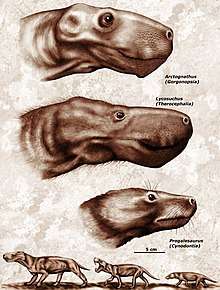Theriodontia
The theriodonts or Theriodontia ("the ones with beast teeth", referring to more mammal-like teeth) are a major group of therapsids. They can be defined in traditional, Linnaean terms, in which case they are a suborder of synapsids that lived from the Middle Permian to the Middle Cretaceous, or in cladistic terms, in which case they include not only the traditional theriodonts but also their descendants the mammals as well (in the same way that, cladistically speaking, the theropod dinosaurs include the birds as a sub-clade).
| Theriodonts | |
|---|---|
 | |
| Scientific classification | |
| Kingdom: | Animalia |
| Phylum: | Chordata |
| Clade: | Therapsida |
| Clade: | Neotherapsida |
| Clade: | Theriodontia Owen, 1876 |
| Groups | |
Naming
In 1876, Richard Owen named a suborder Theriodontia, which he divided into the Cynodontia and the Gomphodontia.[1]
The modern clade concept was devised by James Allen Hopson. In his system, Theriodontia fall into two main groups: the Gorgonopsia and the Eutheriodontia. The latter consist of the Therocephalia and Cynodontia.[2]
Evolution
Theriodonts appeared at the same time as their sister group within the Neotherapsida, the Anomodontia, about 265 million years ago, in the Middle Permian. Even these early theriodonts were more mammal-like than their anomodont and dinocephalian contemporaries.
Early theriodonts may have been warm-blooded. Early forms were carnivorous, but several later groups became herbivorous during the Triassic. Theriodont jaws were more mammal-like than was the case of other therapsids, because their dentary was larger, which gave them more efficient chewing ability. Furthermore, several other bones that were on the lower jaw (found in reptiles), moved into the ears, allowing the theriodonts to hear better and their mouths to open wider. This made the theriodonts the most successful group of synapsids.
Eutheriodontia
Eutheriodontia refers to all theriodonts except the gorgonopsians (the most "primitive" group). They included the therocephalians and the cynodonts. The cynodonts include the mammals. The name means "true beast tooth". The eutheriodonts have larger skulls, accommodating larger brains and improved jaw muscles.
The eutheriodontian theriodonts are one of the two synapsid survivors of the great Permian–Triassic extinction event, the other being the dicynodonts. Therocephalians included both carnivorous and herbivorous forms; both died out after the Early Triassic. The remaining theriodonts, the cynodonts, also included carnivores, such as Cynognathus, as well as newly evolved herbivores (Traversodontidae). While traversodontids for the most part remained medium-sized to reasonably large (the length of the largest species was up to two meters), the carnivorous forms became progressively smaller as the Triassic progressed. They "miniaturised". By the Late Triassic, the small cynodonts included the rodent-like Tritylodontidae (possibly related to or descended from traversodontids), and the tiny, shrew-like, Trithelodontidae, related to the Mammaliaformes. The trithelodontids died out during the Jurassic, and the tritylodontids survived into the Cretaceous, but their relatives, the mammals, continued to evolve. Many mammal groups managed to survive the Cretaceous–Paleogene extinction event, which wiped out the non-avian dinosaurs, allowing the mammals to diversify and dominate the Earth.
Taxonomy
Classification
- Order Therapsida
- Theriodont *
- Suborder †Gorgonopsia
- Family †Gorgonopsidae
- Eutheriodontia
- Suborder †Therocephalia
- Family †Lycosuchidae
- (unranked) †Scylacosauria
- Family †Scylacosauridae
- Infraorder †Eutherocephalia
- Family †Hofmeyriidae
- Family †Moschorhinidae
- Family †Whaitsiidae
- Superfamily †Baurioidea
- Family †Bauriidae
- Family †Ericiolacteridae
- Family †Ictidosuchidae
- Genus †Ictidosuchoides
- Genus †Ictidosuchus
- Family †Ictidosuchopsidae
- Family †Lycideopidae
- Suborder Cynodontia
- Suborder †Therocephalia
- Suborder †Gorgonopsia
- Theriodont *
Phylogenetics of Theriodontia
- Therapsida
- Mammals and extinct relatives
- †Biarmosuchia
- †Eotitanosuchia
- †Dinocephalia
- †Anomodontia
- Theriodontia
See also
- Evolution of mammals
- Anomodonts
- Timeline of evolution
References
- Owen, R. 1876. Descriptive and illustrated catalogue of the fossil Reptilia of South Africa in the collection of the British Museum. London. Taylor and Francis. 88 pp
- J.A. Hopson. 1999. "Therapsids". Encyclopedia of Paleontology 2: 1256-1266
External links
- Theriodontia - at Paleos
